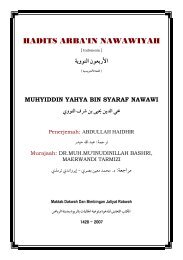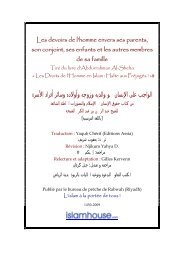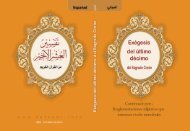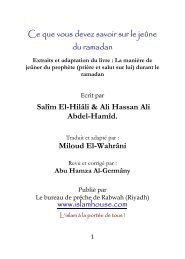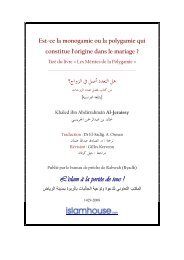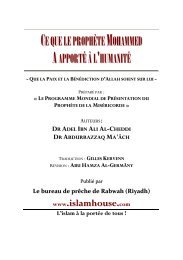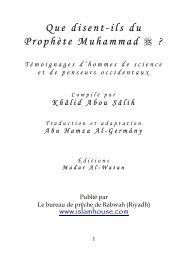is allah (sw) one or three? - Islam Center
is allah (sw) one or three? - Islam Center
is allah (sw) one or three? - Islam Center
You also want an ePaper? Increase the reach of your titles
YUMPU automatically turns print PDFs into web optimized ePapers that Google loves.
(١٠)IS ALLAH (S.W) ONE OR THREE?“It <strong>is</strong> a fabrication, as the w<strong>or</strong>d ‘God’ does not ex<strong>is</strong>t in the <strong>or</strong>iginalcodex, instead it contains the third person subject pronoun ‘He’ <strong>or</strong>the demonstrative pronoun ‘That <strong>or</strong> which’ ”.Explaining the reason, h<strong>is</strong>t<strong>or</strong>y and time f<strong>or</strong> th<strong>is</strong> fabrication, PriestJames Anas says,“What makes the reading with the w<strong>or</strong>d ‘which’ m<strong>or</strong>e accurate, <strong>is</strong> thatthe old theologians did not mention it among the many verses, whichthey produced while they were refuting Arius. The reason f<strong>or</strong> thatchange in the New Greek Manuscripts <strong>is</strong> the similarity between thetwo w<strong>or</strong>ds. They both look alike in writing; the only differencebetween them <strong>is</strong> a small hyphen <strong>or</strong> a little dot. Most probably, thewriters added th<strong>is</strong> little line to clarify the meaning, thus, changing thew<strong>or</strong>d from ‘which’ to ‘God’. Then it spread over many copies in themiddle centuries; conflicting what was found in the ancient copies,which contain only the w<strong>or</strong>d ‘That’”. 1If we read Paul’s above-menti<strong>one</strong>d verse c<strong>or</strong>rectly, apart from theedit<strong>or</strong>’s intended fabrication, we will find that it talks about theappearance of godliness in a living body, but the new translationschanged it to evidence f<strong>or</strong> God’s incarnation in Jesus (PBUH).The Catholic Jesuits edition, the Douay-Rhiems Bible, and theMurdock Bible deleted the fabrication and c<strong>or</strong>rected the verse. Itreads, “Great <strong>is</strong> the mystery of godliness: which wasmanifest in the flesh”. (Ti 1, 3:16), replacing the w<strong>or</strong>d ‘God’ withthe accurate w<strong>or</strong>d, ‘which’. Consequently, changing the meaning andthe evidence f<strong>or</strong> God’s incarnation in Jesus (PBUH) hadd<strong>is</strong>appeared.Another example of these fabrications <strong>is</strong> the translat<strong>or</strong>s’ alteration inthe Ep<strong>is</strong>tle of Jude. In the most famous and popular ProtestantEdition, the Rev<strong>is</strong>ed King James Version, we find what woulddeceive and delude the reader. It reads, “Now to him that <strong>is</strong> ableto keep you from falling, and to present you faultless bef<strong>or</strong>ethe presence of h<strong>is</strong> gl<strong>or</strong>y with exceeding joy, to the onlyw<strong>is</strong>e God our Savoir, be gl<strong>or</strong>y and majesty, dominion andpower, both now and ever.” (Jud 1:24-25)The fact <strong>is</strong>, that the verse mentions the ‘Savi<strong>or</strong> God’ that would savepeople by Jesus’ (PBUH) m<strong>is</strong>sion and message, but not about Jesus1 - Methodical Theology, James Anas, pp 206. The Truth Revealed, Vol.2, pp 460.




